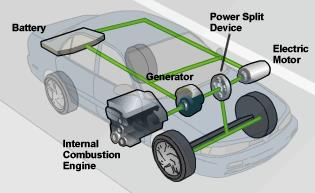 Electric Car
Electric Car
For the House
HOW DOES IT WORK?
There is a range of different types of energy efficient vehicles available to consumers in Australia including hybrid electric vehicles (HEV), plug-in hybrid electric vehicles (PHEV) and electric vehicles (EV).
These different types of vehicle technology exist because different vehicle technologies are suited to different types of driving. See the following link for a graphical representation - vehicle technology trip distribution diagram
HOW MUCH CAN I SAVE?
There are a number of factors to consider including initial purchase price, servicing, repairs, resale value etc, however if we simply consider fuel costs then the savings can be considerable. The average family sized car will use around 11-12 litres per 100km, whereas a hybrid vehicle can use as little as 3-4 litres per 100km. Over a 1000km trip with a fuel price of $1.50 per litre, that represents a saving of around $120.00.
HOW MUCH DOES IT COST?
We all know that vehicle costs vary considerably so it is difficult to provide a cost. However it is fair to say that in the ‘apples to apples’ comparison the hybrid vehicle will be more expensive that the standard fuel equivalent. This is mostly due to the technology of the vehicle which, like most technology costs, is becoming more affordable with each new model. To learn more information and to obtain a quote on an electric vehicle click here.
GOVERNMENT INCENTIVES
The availability of energy efficiency programs and/or incentives for energy efficient vehicles may vary from state to state. For the latest information we recommend requesting a quote from a professional energy efficiency company.
MORE INFORMATION
The following provides a summary of the major characteristics of the three main types of energy efficient vehicles.
Hybrid vehicles
Hybrid cars have a petrol engine and an electric motor but do not plug into a power source. Battery-stored electricity is generated by the petrol driven engine and/or energy usually lost due to braking.
The electric motor and the petrol-driven combustion engine can power the car alone or in combination depending on the driving conditions.
The best selling Australian examples are the Toyota Prius and Camry Hybrid and the Lexus Hybrid.
Plug-in hybrid vehicles
Like an ordinary hybrid, a plug-in hybrid has a petrol engine and an electric motor. However, a plug-in hybrid gets its electrical energy from plugging into the electricity grid as well as from within the vehicle.
Plug-in hybrids are mostly driven on their electric motor with the petrol engine there for back-up. In some cars it drives the car once the battery power is exhausted while in other cars it is used to charge the battery.
The best selling Australian example is the Holden Volt.
Electric vehicles
Electric cars run entirely on electricity with power stored in an on-board battery that is recharged by connecting it to an electricity supply (usually the 'mains'). When required, energy is drawn from the electric-cells and converted to motive power by the use of one or more electric motors.
The best selling Australian examples are the Mitsubishi i-MIEV and the Nissan Leaf.
Energy Savings
While there is no doubt that you will pay more for an energy efficient vehicle there is also little doubt that fuel prices will continue to rise and therefore increase the cost of running a conventional vehicle. Consider also that all types of energy efficient vehicles are getting cheaper as consumer uptake increases and the market becomes more competitive.
Calculating the savings to be made in running an energy efficient vehicle is complex. Variables like the cost of electricity in your region (and whether you can access off-peak power), how you use your vehicle and how long you are likely to have the vehicle need to be taken into account.
The Green Vehicle Guide maintained by the Australian Department of Infrastructure and Transport provides a thorough guide that allows you to make comparisons of fuel efficiency, carbon output and energy usage for each car you are interested in. The guide also gives each vehicle a greenhouse and pollution rating.
Click on the link to view an example for the Mitsubishi i-MIEV.




